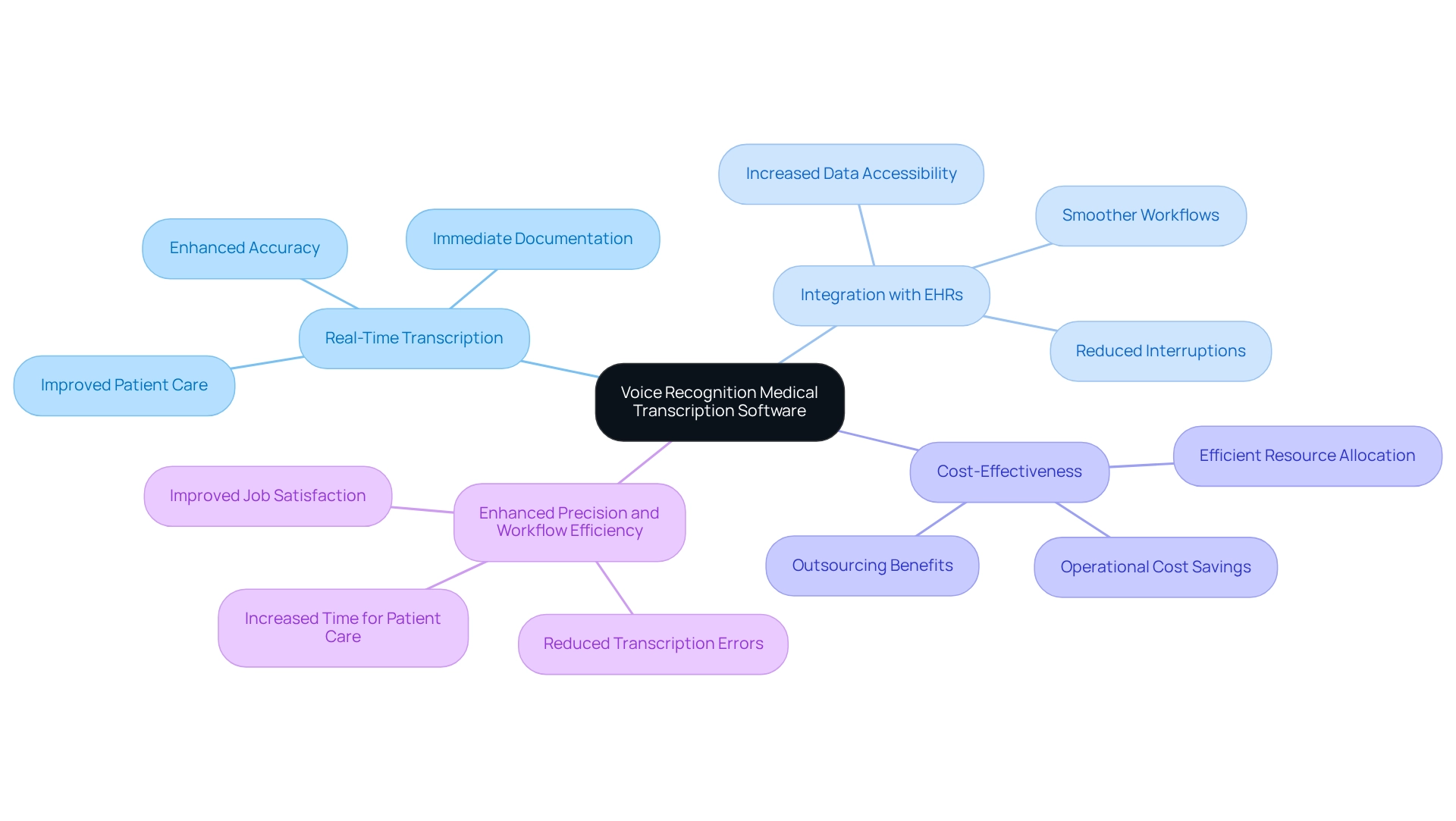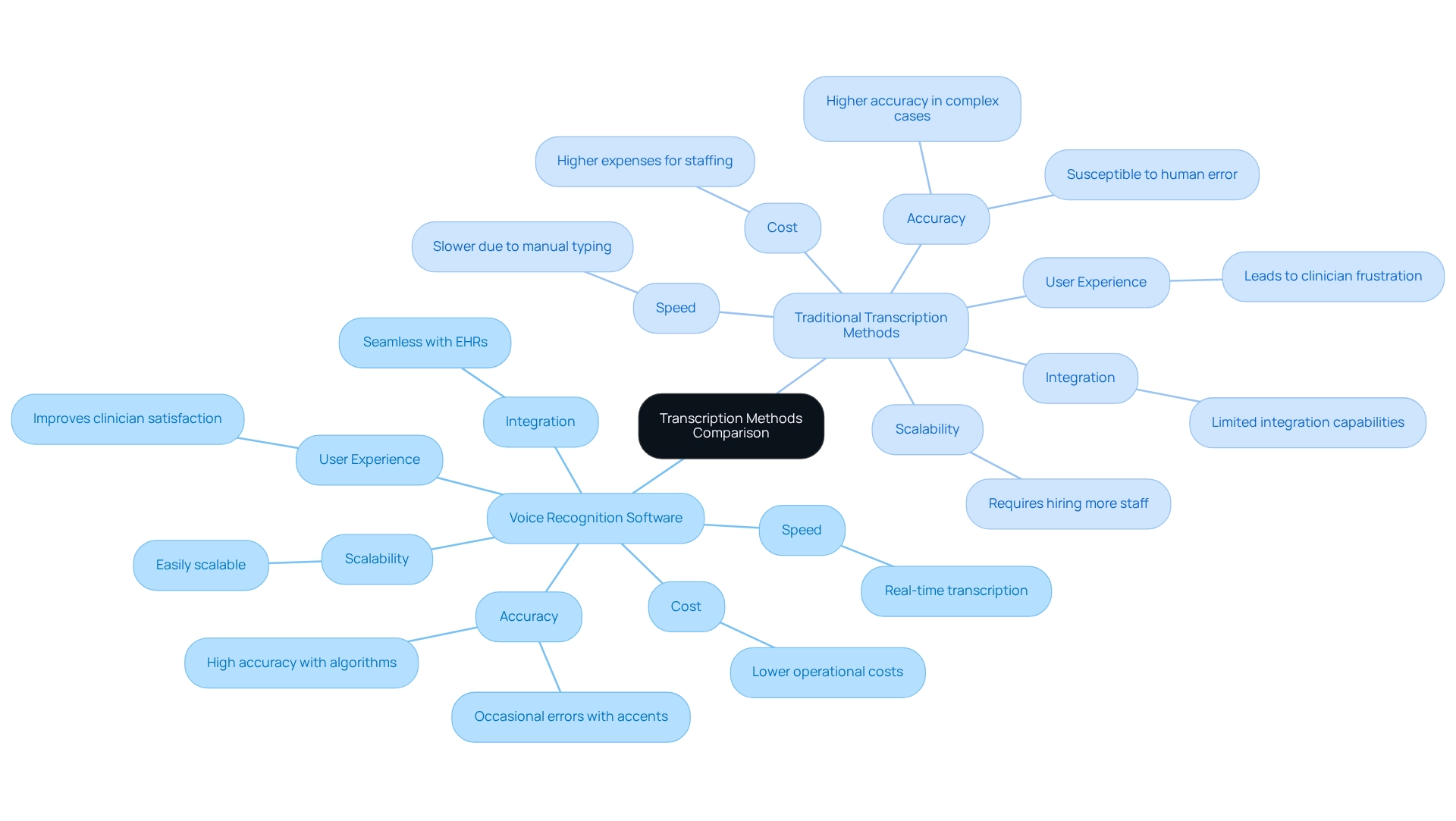Overview
Healthcare providers often face overwhelming administrative burdens that can detract from their primary focus: patient care. Voice recognition medical transcription software offers a compassionate solution to these challenges, providing significant advantages over traditional methods. Imagine a world where documentation is not a source of stress but a streamlined process that enhances speed, cost-effectiveness, and accuracy.
This innovative technology transforms real-time transcription, allowing healthcare professionals to devote more time to their patients. By reducing the tedious aspects of documentation, it integrates seamlessly with electronic health records, creating a smoother workflow. How much more could you achieve if you spent less time on paperwork and more on patient interactions?
The benefits are clear: enhanced efficiency, reduced administrative burdens, and improved accuracy in documentation. This not only supports healthcare providers but ultimately leads to better patient outcomes. We invite you to explore how adopting voice recognition technology can transform your practice and help you focus on what truly matters—caring for your patients.
Introduction
In the fast-paced world of healthcare, we understand that the efficiency of documentation processes can deeply impact both patient care and operational effectiveness. Many healthcare providers face the emotional burden of traditional transcription methods that often fall short in speed and accuracy. However, innovative voice recognition software is emerging as a beacon of hope, utilizing artificial intelligence to transform spoken language into text seamlessly.
This technology not only accelerates the documentation process but also alleviates the pressure on human transcriptionists, significantly reducing errors and allowing healthcare providers to reclaim precious time. As the industry embraces automation, it is essential for healthcare professionals to grasp the differences between these two approaches. By doing so, they can optimize their practices and ultimately enhance patient outcomes.
Have you ever felt overwhelmed by the administrative tasks that take time away from patient interaction? Understanding these advancements can empower you to focus more on what truly matters—providing compassionate care to your patients. Let’s explore how embracing these solutions can lead to a more efficient and nurturing healthcare environment.
Understanding Voice Recognition Software and Traditional Transcription Methods
Voice recognition medical transcription software harnesses the power of artificial intelligence to transform spoken language into text. This advancement allows medical providers to utilize voice recognition medical transcription software to dictate notes directly into electronic health records (EHRs), alleviating some of the burdens they face. Have you ever felt overwhelmed by the sheer volume of administrative tasks? This technology, specifically voice recognition medical transcription software, has made remarkable strides, now offering features like real-time transcription and seamless integration with various medical systems. In contrast, traditional transcription methods rely on human transcribers who listen to recorded audio from medical providers and manually convert it into written documents. While these methods have been reliable in the past, they often fall short in today’s fast-paced medical environment. They can be slower and more susceptible to human errors, which can impact patient care. As we look towards 2025, statistics reveal a growing preference for speech technology, with 74% of users opting for mobile speech assistants at home. This trend underscores a broader movement towards automation and efficiency in healthcare.
Key players in the speech identification software market, such as Apple Inc., Amazon Web Services, and IBM Corporation, are continually innovating to enhance these technologies. This ongoing development is vital for their adoption in medical settings. By automating labor-intensive administrative tasks—like appointment scheduling, medical record management, and billing—voice recognition medical transcription software significantly enhances documentation efficiency. This not only saves time but also allows medical providers to focus on what truly matters: delivering high-quality care to their patients.
Expert opinions suggest that incorporating speech identification software can ease the challenges faced by medical practitioners. It’s essential to understand the differences between voice recognition medical transcription software and conventional transcription methods, especially regarding . Embracing these innovations can lead to a more efficient and compassionate healthcare experience for both providers and patients alike.
Key Benefits of Voice Recognition Software:
- Increased efficiency in documentation
- Reduced administrative burden
- More time for patient care
In conclusion, as we navigate the complexities of healthcare, it’s crucial to explore solutions that support our providers. Let’s embrace these advancements together, fostering a more supportive and effective healthcare environment.
Key Features and Advantages of Voice Recognition Medical Transcription Software
presents a range of essential features that can significantly alleviate the burdens faced by healthcare providers in medical settings.
- Real-Time Transcription: Imagine being able to dictate notes during client interactions—this feature drastically reduces the time spent on documentation. The immediacy of real-time transcription streamlines the process, enhancing the accuracy of client records. This means more thorough and timely documentation that ultimately benefits patient care.
- Integration with EHRs: Many voice recognition systems seamlessly integrate with existing electronic health records (EHRs). This integration facilitates smoother workflows and enhances data accessibility for providers. By reducing interruptions in clinical workflows, it allows providers to focus more on their interactions with clients.
- Cost-Effectiveness: Consider the significant operational cost savings that medical facilities can achieve by decreasing dependence on human transcriptionists. This shift enables resources to be allocated more efficiently, ultimately improving care for individuals. As medical providers increasingly outsource transcription services, the cost savings from utilizing speech processing software become even more apparent.
- Enhanced Precision and Workflow Efficiency: With the use of advanced algorithms and machine learning, speech processing software significantly reduces transcription errors. This ensures that clinical records are accurate and trustworthy, leading to improved outcomes for individuals. Moreover, as the administrative load of documentation decreases, clinicians can devote more time to patient care, enhancing job satisfaction among medical providers and improving overall outcomes for those receiving treatment. Together, these attributes position voice recognition medical transcription software as a transformative tool in medical documentation, aligning with the evolving objectives of contemporary medical practices. By streamlining processes such as appointment scheduling and medical record management, this technology empowers providers to reclaim valuable time, ultimately enhancing the care they provide to individuals.
How might this technology change your daily practice? It’s time to explore these advancements and see how they can support you in your vital work.

Characteristics and Limitations of Traditional Transcription Methods
Traditional transcription methods present several notable limitations that can significantly impact healthcare documentation, affecting both providers and patients alike.
- Manual Process: These methods depend on human transcriptionists who listen to audio recordings and transcribe the content. This labor-intensive process is not only time-consuming but can lead to inefficiencies in documentation, ultimately affecting patient care.
- Higher Error Rates: Human error is a critical concern, especially with complex medical terminology or poor audio quality. A 2019 study from VIPVIZA highlighted eight transcription errors in LDL-C readings, resulting in for individuals. Such inaccuracies can have serious consequences for patient outcomes.
- Costly: The financial burden of employing transcriptionists can be substantial, particularly for practices generating a high volume of documentation. These expenses can strain operational budgets, diverting essential resources away from patient care.
- Delayed Turnaround: The time required to transcribe audio recordings can delay access to medical records, hindering . This lag can adversely affect patient outcomes and overall care quality.
- Limited Scalability: As patient volumes increase, traditional transcription methods often struggle to keep pace, creating bottlenecks that compromise documentation efficiency.
These challenges underscore the urgent need for more effective solutions in healthcare documentation, including voice recognition medical transcription software. As Li Zhou, MD, PhD, noted, "These findings indicate a need not only for clinical quality assurance and auditing programs but also for clinician training and education to raise awareness of these errors and strategies to reduce them." Many organizations have begun outsourcing manual data entry tasks to enhance accuracy, speed, and consistency while reducing operational costs. This approach demonstrates a practical solution to the constraints of conventional transcription techniques, paving the way for the integration of voice recognition medical transcription software, which can improve accuracy, speed, and overall efficiency in medical transcription.
How can we better support our healthcare providers in overcoming these challenges? By acknowledging their struggles and seeking innovative solutions, we can ensure that patient care remains the top priority.
Comparative Analysis: Voice Recognition vs. Traditional Transcription Methods
Feature/Aspect | Voice Recognition Software | Traditional Transcription Methods
------------------------------------|-----------------------------------------------|------------------------------------------------
Speed | Enables real-time transcription, facilitating immediate documentation. | Slower due to manual typing and processing time.
Cost | Generally incurs lower operational costs by minimizing staffing needs. | Higher expenses associated with hiring transcriptionists.
Accuracy | Offers high accuracy through advanced algorithms, though occasional errors may occur, particularly with accents and similar-sounding words. | Can achieve higher accuracy in complex cases but is susceptible to human error.
Integration | Seamlessly integrates with Electronic Health Records (EHRs), enhancing workflow efficiency. | Limited integration capabilities, often necessitating additional steps.
Scalability | Easily scalable to manage increasing patient volumes without significant additional costs. | Scaling requires hiring more staff, leading to increased operational costs.
User Experience | Improves clinician satisfaction by alleviating the documentation burden. | Often leads to clinician frustration due to time-consuming processes.
This comparative analysis highlights the emotional challenges faced by healthcare providers. The administrative burdens can significantly impact patient care, leading to frustration and burnout. However, it’s important to recognize that both transcription techniques have their merits. Yet, voice recognition medical transcription software stands out in terms of speed, cost-efficiency, and user experience, making it a compassionate choice for modern medical providers.
As we navigate the evolving landscape of healthcare, the demand for intelligent solutions only grows. The advancements in voice recognition medical transcription software underscore the vital role of auditory identification in this transformation. Moreover, has seen remarkable growth, driven by technological innovations and the increasing reliance on smart devices. This trend indicates a bright future for voice recognition in healthcare.
As Brian Moore, VP of NICCA USA, Inc., noted, 'The quality of research they have done for us has been excellent.' This reflects the ongoing improvements and innovations in this field, reinforcing the supportive journey towards better healthcare solutions.

Conclusion
Embracing voice recognition software represents a pivotal shift in the healthcare documentation landscape. This innovative technology not only enhances efficiency but also significantly alleviates the emotional and operational burdens that healthcare providers face with traditional transcription methods. By offering features such as real-time transcription and seamless integration with electronic health records, voice recognition software allows healthcare professionals to focus more on what truly matters: patient care.
The transition from manual transcription to voice recognition is marked by notable advantages, including improved accuracy, cost-effectiveness, and scalability. Traditional methods can often lead to delays and higher error rates, causing frustration among clinicians. In contrast, voice recognition technology streamlines documentation processes, enabling healthcare professionals to reclaim valuable time. This shift not only enhances job satisfaction but also fosters better patient outcomes, ultimately creating a more compassionate and effective healthcare environment.
As the healthcare industry continues to evolve, understanding the distinctions between these two approaches is crucial. By harnessing the power of voice recognition software, healthcare providers can optimize their practices, reduce operational costs, and improve the quality of care delivered to patients. The future of healthcare documentation lies in embracing these advancements, paving the way for a more efficient and patient-centered approach to care. How might your practice benefit from these innovations?




